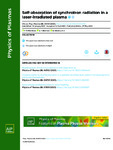Self-absorption of synchrotron radiation in a laser-irradiated plasma
| dc.contributor.author | Blackburn, TG | |
| dc.contributor.author | MacLeod, AJ | |
| dc.contributor.author | Ilderton, Anton | |
| dc.contributor.author | King, Ben | |
| dc.contributor.author | Tang, S | |
| dc.contributor.author | Marklund, M | |
| dc.date.accessioned | 2021-09-28T10:05:20Z | |
| dc.date.issued | 2021-05-07 | |
| dc.identifier.issn | 1070-664X | |
| dc.identifier.issn | 1089-7674 | |
| dc.identifier.other | 053103 | |
| dc.identifier.uri | http://hdl.handle.net/10026.1/17960 | |
| dc.description.abstract |
<jats:p>Electrons at the surface of a plasma that is irradiated by a laser with intensity in excess of 1023 W cm−2 are accelerated so strongly that they emit bursts of synchrotron radiation. Although the combination of high photon and electron density and electromagnetic field strength at the plasma surface makes particle–particle interactions possible, these interactions are usually neglected in simulations of the high-intensity regime. Here we demonstrate an implementation of two such processes: photon absorption and stimulated emission. We show that, for plasmas that are opaque to the laser light, photon absorption would cause complete depletion of the multi-keV region of the synchrotron photon spectrum, unless compensated by stimulated emission. Our results motivate further study of the density dependence of quantum electrodynamics phenomena in strong electromagnetic fields.</jats:p> | |
| dc.format.extent | 053103- | |
| dc.language | en | |
| dc.language.iso | en | |
| dc.publisher | AIP Publishing | |
| dc.title | Self-absorption of synchrotron radiation in a laser-irradiated plasma | |
| dc.type | journal-article | |
| dc.type | Journal Article | |
| plymouth.author-url | https://www.webofscience.com/api/gateway?GWVersion=2&SrcApp=PARTNER_APP&SrcAuth=LinksAMR&KeyUT=WOS:000678720500001&DestLinkType=FullRecord&DestApp=ALL_WOS&UsrCustomerID=11bb513d99f797142bcfeffcc58ea008 | |
| plymouth.issue | 5 | |
| plymouth.volume | 28 | |
| plymouth.publication-status | Published | |
| plymouth.journal | Physics of Plasmas | |
| dc.identifier.doi | 10.1063/5.0044766 | |
| plymouth.organisational-group | /Plymouth | |
| plymouth.organisational-group | /Plymouth/Faculty of Science and Engineering | |
| plymouth.organisational-group | /Plymouth/Faculty of Science and Engineering/School of Engineering, Computing and Mathematics | |
| plymouth.organisational-group | /Plymouth/REF 2021 Researchers by UoA | |
| plymouth.organisational-group | /Plymouth/REF 2021 Researchers by UoA/EXTENDED UoA 10 - Mathematical Sciences | |
| plymouth.organisational-group | /Plymouth/REF 2021 Researchers by UoA/UoA10 Mathematical Sciences | |
| plymouth.organisational-group | /Plymouth/Users by role | |
| plymouth.organisational-group | /Plymouth/Users by role/Academics | |
| plymouth.organisational-group | /Plymouth/Users by role/Researchers in ResearchFish submission | |
| dcterms.dateAccepted | 2021-04-12 | |
| dc.rights.embargodate | 2021-9-29 | |
| dc.identifier.eissn | 1089-7674 | |
| dc.rights.embargoperiod | Not known | |
| rioxxterms.funder | Engineering and Physical Sciences Research Council | |
| rioxxterms.identifier.project | Quantum phenomena in high-intensity laser-matter interactions | |
| rioxxterms.versionofrecord | 10.1063/5.0044766 | |
| rioxxterms.licenseref.uri | http://www.rioxx.net/licenses/all-rights-reserved | |
| rioxxterms.licenseref.startdate | 2021-05-07 | |
| rioxxterms.type | Journal Article/Review | |
| plymouth.funder | Quantum phenomena in high-intensity laser-matter interactions::Engineering and Physical Sciences Research Council |


